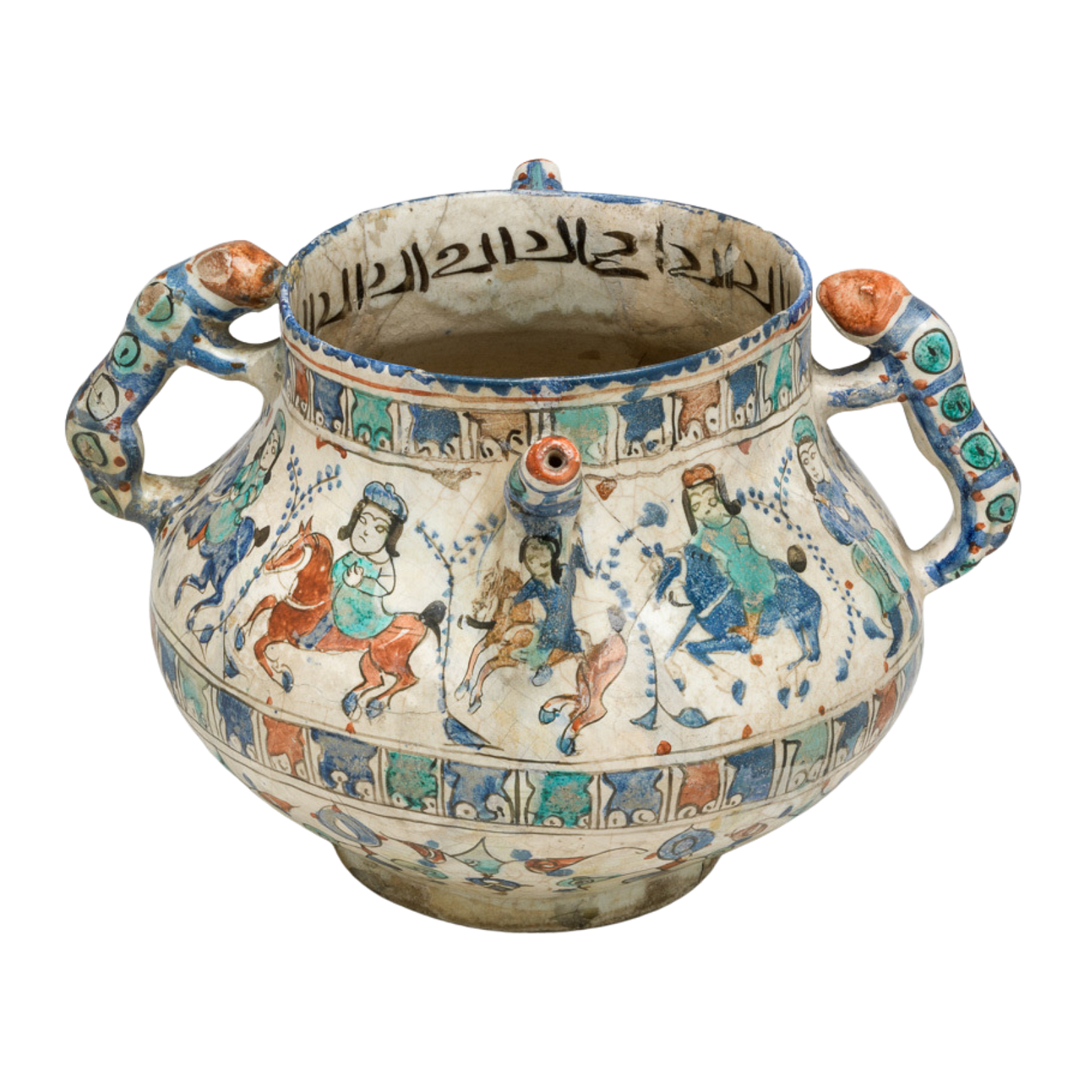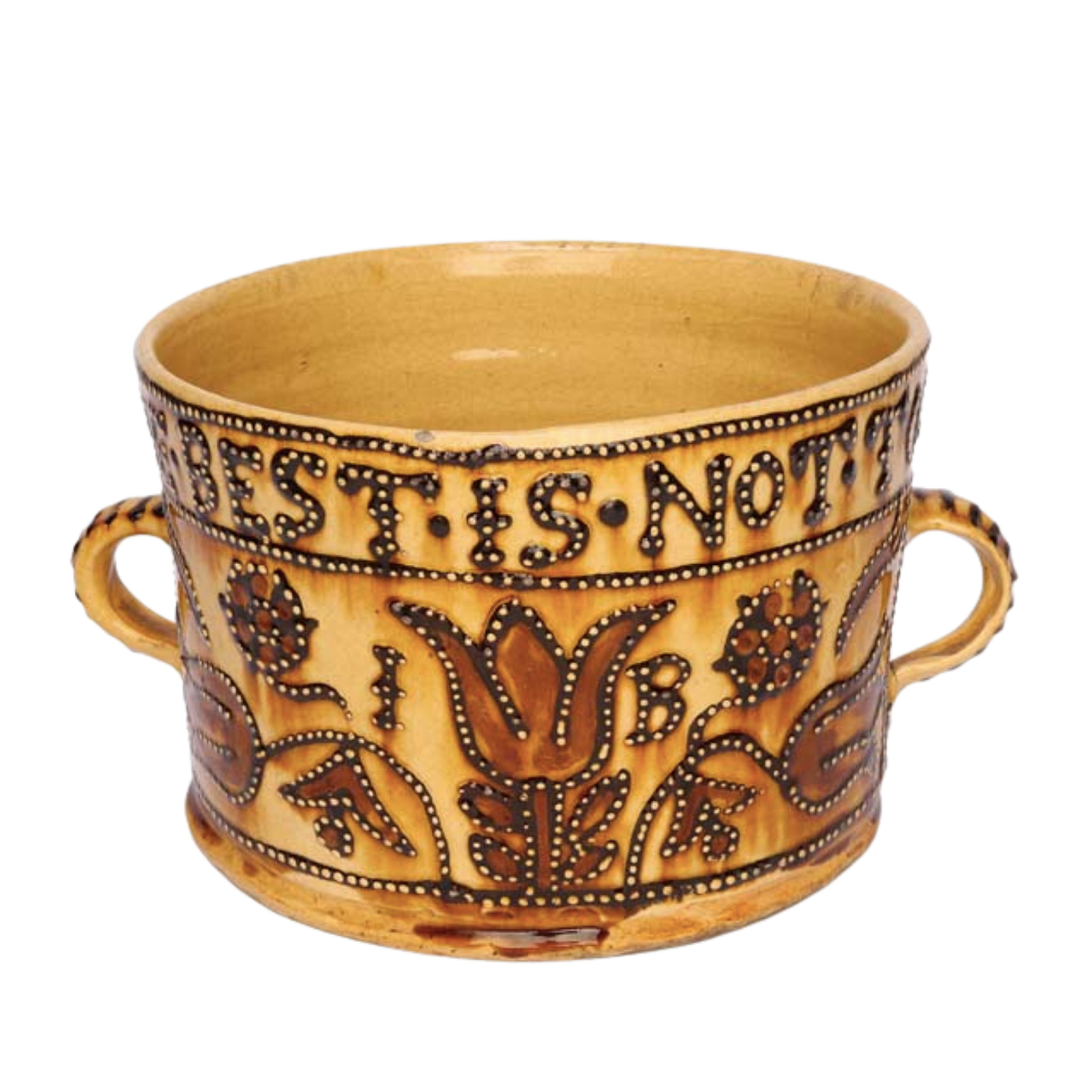Studio Research: Posset Pots Part One
From Kashan to Staffordshire, and where have all the lids gone?
What is a Posset Pot?
Posset pots are vessels with an unusual form – a cylindrical cup, with a thin spout from the base up to above the rim and two handles either side, and often a lid. They were made, seemingly, for drinking posset- milk or cream mixed with spiced ale or wine, which would cause it to curdle. The spout would act as a straw that allowed you to drink the spiced alcohol from the bottom of the cup, whilst the thicker curds could be eaten with a spoon from the top of the vessel. In Randle Holme’s An Academic or Storehouse of Armory and Blazon (c.1663—82, figure 44) he illustrates a posset pot, describing it as ‘a posset pott, or a wassell cup, or a sallibube pott, having 2 handles, with a pipe on the side’. This would suggest that as well as posset, the cups were used in the Wassail ceremony- performed on Twelfth Night, participants would drink spiced and sweetened ale which had the pulp of apples mixed into it. Syllabub was much the same as posset- cream or milk curdled by alcohol.
The most famous cultural reference to posset that I could find was in Act II of Macbeth, when the guards outside Duncan’s quarters are disposed of with tampered possets:
The doors are open, and the surfeited grooms
Do mock their charge with snores. I have drugg'd their possets
That death and nature do contend about them,
Whether they live or die.
A posset set was gifted by the Spanish Ambassador to Queen Mary I of England and King Phillip II of Spain when they got engaged in 1554, now on display in Hatfield House it was made of crystal, gold, gems and enamel. These sets were popular gifts and contained mixing bowls, spoons and cups. This seems a lot more elaborate than a simple cup with a spout?
The earliest examples of the posset pot form that I could find were from Iran, in a style regarded as from the city of Kashan, and dated from the 12th century. As far as I’m aware it is unknown what the function of these would have been, and I can’t find anything citing posset as being drunk in Iran in the 12th century- I would love to know if anyone has any thoughts.
Lustre decorated spouted pot. C.1100-1200. From the collections of the Fitzwilliam Museum, Cambridge.
Another one here in the collections of the V&A Museum, London and here in the Fitzwilliam, Cambridge. There are interestingly also some later posset pot forms made in Iran, here and here from the late 17th early 18th century. There is some suggestion that these later pieces were influenced by the function of drinking posset.
There are also a number of UK made glass posset pots in the V&A collections, dating from the 17th and 18th centuries.
Posset pot, mould-blown and diamond engraved with birds and trees, possibly made by George Ravenscroft at the Savoy Glasshouse, London, 1677-1690.
The above example is more elaborate, with those beautiful engravings of birds, but there are some plainer versions here, here, and here.
Slipware Posset Pots
Posset pot with cover, early 18th century, Staffordshire. From the collections of the Metropolitan Museum of Art.
Determining a vessel’s function by it’s form – Is it a Posset Pot or a Handled Cup?
“The term ‘posset pot’ is used loosely for a variety of large cups with two or more handles. However, some of these may never have been intended to hold posset, highlighting the problem of attempting to determine a vessel’s function by it’s form.” (Leslie B Grigsby English Slip-Decorated Earthenware at Williamsburg.)
It is quite difficult to tell at times whether a piece was a handled cup with a lid, or just a handled cup, as the lids are easily lost or broken over time- leaving us with just the cup. I’ve looked at pieces labelled ‘posset pots’ in museums so many times over the years and not given the labelling much thought, but this week looking at them all at once I started to feel doubtful that many of the handled cups named ‘posset pots’ in museum collections were intended for posset, without any spout. It seems like most handled cups have been named as posset pots. It’s also seemingly quite difficult to find examples with lids- if anyone has any good examples please let me know.
These multi handled cups without lids were sometimes called ‘loving cups’ by later collectors of ceramics. The cups are widely thought to have been passed around groups of drinkers during toasts, and sometimes designed to commemorate important occasions (and may of course just been…special cups for drinking). Examples of inscriptions include (v’s =u’s)
“GEORGE:WARD:MADE:THIS:CVP:AN:D:SO:NO:MORE:BVT:GOD:BLESS:THE:QUEEN:AND:ALL:HER:PALERME:” (Referring to Queen Anne) in the Glaisher collection at the Fitzwilliam Museum, Cambridge.
“TOMAS DAKIN MADE TIS CUP FOR MARY CULL THARP OR FOR HER FRIEND AD 1710” from the V&A Museum, London.
The inscription on this Staffordshire cup from 1710 seems to really blur the line between a spouted posset pot and a handled cup, stating:
ROBERT POOL MAD THIS CUP AND WITH A GUD POSET FIL
(This cup was sold at Christie’s in 1992 and later given by Miss E Newmarch to the V&A Museum collections). It appears that Robert Pool, the potter, is implying that it should be used for posset, but there is no spout!
Posset Pot c.1710, by Robert Pool, from the collections of the V&A Museum, London.
A potential explanation for the lack of spouts can be found in the description of two 16th century ‘ox-eye’ posset pots gifted to Corpus Christi College, Cambridge, by Matthew Parker, born in Norwich, who was a Master at the college and later Archbishop of Canterbury under Elizabeth I. The exhibition notes from ‘Feast and Fast The Art of Food in Europe 1500-1800’ state:
“The narrow top was supposed to help gather the floating foam and set custard below, so it could be eaten with a spoon, before the pot was picked up by both handles, and drunk from.”
Stafforshire Posset Pots
Whilst posset pots appear in varying shapes and sizes, the north Staffordshire posset pots (dating from 17th/18th century) documented in the Potteries Museum collection largely follow a similar form. They tend to be straight sided, cylindrical or slightly flaring with a shoulder marking the start of the neck, and a handle at each side. Further exemplifying the problem identifying between posset pots and handled cups, Leslie B. Grigsby states that they “sometimes have sucking spouts, or decorative lugs or scrolls between the handles”. (English Slip-Decorated Earthenware at Williamsburg )
As is found across slipware from the period, the decoration on Staffordshire pieces ranges from simple spotting or feathering to layers of trailed and jewelled decoration, sometimes including inscriptions naming owner, maker or date, or lines of verse.
The inscription ‘THE BEST IS NOT TOO GOOD FOR YOU’ appears twice in pieces from the Potteries Museum collection illustrated in the Barker/Cromptons published overview.
One of these appearances is on the cup pictured below, dated 1697, which “was probably given as a congratulatory gift at a wedding or other festive event”. (Leslie B Grigsby, English Slip-Decorated Earthenware at Williamsburg.)
Two handled posset pot decorated with slips and dated 1696. The Potteries Museum and Art Gallery.
Incidentally, the pot gave it’s name to a Contemporary Art Society exhibition at Whitechapel Gallery in 2014. With pieces drawn from the collections of member museums across the midlands, the posset pot was loaned to the exhibition by The Potteries Museum and Art Gallery in Stoke-on-Trent. A fitting name for an exhibition focussing on opening private and museum collections to more people.
Fineware vs Local Earthenwares and the Expansion of Staffordshire Pottery
These slipware posset pots would have been made by fineware potters, whilst local earthenware potters supplied heavier, more utilitarian and cheaper pots- mostly for baking, brewing, cheese making and almost all kitchen wares. As described in Jo Draper’s Book Post Medieval Pottery, the final quality and design of the local earthenwares really came down to the individual potters at work- their skill and experience level, relationship with their customers and the influence of local traditions of pottery making: “slip-decorated pots are not necessarily better than the plain earthenwares… many are handsome objects…highly functional, very beautiful and the epitome of good design”. In some cases however, a single pottery would be producing both the fine wares and plain earthenwares, firing them in the same kilns. It is thought by some historians that in these cases, the fine wares would be made along the plain wares in the same pottery, commissioned for special events, to be given as gifts to commemorate the occasion. It seems unlikely to me that a potter would be able to produce fine slipware on irregular occasion- the process takes so much preparation and development of the slip and technique. It could be that this played out alongside the expansion of slipware utilitarian wares - so the pottery making them would be set up to make more elaborate slipware alongside it.
From the middle of the seventeenth century, small merchants distributed Staffordshire wares (the fineware pottery) all across the UK, which differed from the country potters making plain earthenware pieces that would only be sold at local markets. From about 1660, much larger quantities of more sophisticated slipware was being produced, and became one of the first stages through which North Staffordshire became the largest pottery-producing area in the world (Post Medieval Pottery, Jo Draper). Staffordshire grew particularly well as an area for pottery production because amongst other factors, there was not only an abundance of natural clay in the area, but also one of coal. The use of wood as fuel for glass making and iron-founding had led to a lot of deforestation, leading the government at the time to encourage alternative fuel sources.
Whilst Staffordshire slipware production expanded rapidly, and is found in almost every archaeological group of this date, there were nonetheless many more kilns across the country also producing slipware. “Only a few of the potteries that once existed are now recorded; others live on in the names of streets and fields, and excavations occasionally bring to light remains of a kiln and its associated rubbish dump.” (English Pottery and Porcelain, Geoffry Wills)
That’s all for today, thanks so much for reading. Next time will be a look at London delftware posset pots.









